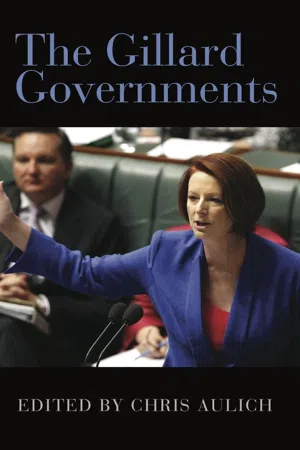![]()
Part 1
Introduction
![]()
1
A Narrative, a Narrative, My Kingdom for a Narrative!
Chris Aulich
Modern Australian politics is unquestionably volatile. The period since Labor assumed government in December 2007 has, however, proved to be one of the most turbulent in modern times, perhaps surprisingly, as it was a period during which the Australian economy achieved growth and proved resilient in the face of the global financial crisis. This chapter identifies the key elements of Julia Gillard’s prime ministership during her three years as prime minister and the two governments she led and provides a framework to, and introduction of, the chapters that follow in this book.
Julia Gillard was elected as party leader in June 2010, replacing Prime Minister Kevin Rudd, who had suffered a serious decline in the polls and about whom many of his closest cabinet colleagues had expressed serious concerns. Chaotic management, constantly changing priorities and accusations of having a ‘tin ear’ were just some of the criticisms made against Rudd to support the decision to elect Gillard as party leader and prime minister.
Any celebration of the appointment of Australia’s 27th prime minister was, however, short lived. Seeking legitimacy for her government, Gillard called an election for August 2010, at which point Labor held a healthy margin in the polls. From that time onwards, however, her standing as prime minister began to fall and, despite the efforts of her and her party, continued on a downward curve through the ensuing three years. Many factors have been discussed as possible causes of her failure to gain traction with the electorate: some have criticised the media for embarking on a relentless campaign of denigration of Gillard and her government; others have argued that her appointment unleashed a basic misogyny among many Australians; some point to ineffective leadership and a failure to generate a vision sufficiently powerful to capture the population. It has also been argued that Tony Abbott performed extraordinarily well as Leader of the Opposition and kept Gillard on the defensive throughout the period. Finally, some point to the persistent undermining of her government from within, and note that this was a critical issue in Gillard failing to secure a majority government in the 2010 election after a series of leaks to the media that were aimed at damaging Gillard personally.
Significantly, the period also brought the ALP more generally into the spotlight for the wrong reasons. The selection of Peter Slipper as Speaker in the House of Representatives was initially applauded as a great tactic to protect the minority government, but the decision soon embarrassed Labor when Slipper was forced to stand down after allegations of sexual harassment were made against him by one of his staff. Similarly, Gillard was criticised for not taking action against Labor member Craig Thomson, though she had for some time reserved her judgement about Thomson’s behaviour on the basis of ‘innocent until proven guilty’. At the same time, several ministers in the former NSW Labor government had serious allegations made against them in the NSW Independent Commission Against Corruption. It is likely that all these cases cast serious concerns about trust and ethics in relation to the Australian Labor Party.
Finally, some have argued that the minority government was itself a cause of the instability, especially as it followed such a long period of stable majority government, at least in the House of Representatives. Each of these factors deserves some consideration here, and each is elaborated both in this chapter and later in the book.
Duelling narratives
Broadly, the line of argument followed in this chapter is that the period was characterised by a contest between different, and ultimately unconvincing, narratives of change. Abbott’s narrative focused on a return to an earlier period of stability that had occurred under Prime Minister Howard. Labor’s narrative focused on a belief that Howard had neglected investment in infrastructure, so Labor’s key policy thrusts were to make up this infrastructure deficit, as well as embarking on a period of reform in key social policy areas, such as health and education. Labor approached its task of reform by: introducing the National Broadband Network (NBN); enhancing funding for schools as one mechanism to stimulate Australia’s labour markets, as well as inject greater equity into school funding; introducing the National Disability Insurance Scheme; instigating and assisting Australian industry to replace its reliance on a carbon-base with climate mitigation as a centrepiece. However, this series of programs and policies was rarely connected to form a coherent narrative or story to convince the electorate that Labor had what Gillard herself called: ‘the power of purpose’ (Gillard 2013). However, any purpose that had been created during her watch was further diluted during the lead up to the 2013 election, as Rudd rarely mentioned, let alone gave credit for, her achievements during the period under review. Unsurprisingly, Gillard commented after the 2013 election that Labor was returning: ‘to opposition having sent the Australian community a very cynical and shallow message about its sense of purpose’ (Gillard 2013).
Abbott has frequently been accused of negativity, though an alternative explanation is that this was a seminal part of his narrative to return Australia to some earlier golden period, perhaps not to the Menzies era that had so appealed to Abbott’s predecessor, John Howard, but nevertheless to some stable, predictable and less complicated earlier period. To cement this narrative, he opposed most of the initiatives for change proposed by Labor and maintained a constant mantra that portrayed Labor as incompetent and unstable. His promise to return to this imagined ‘golden era’ was well captured by Pope in the cartoon that accompanies this chapter (see Figure 1.1).
Abbott’s approach to much of the Labor reform agenda was to oppose it, as typically expected in his role as Opposition Leader. However, this proved to be such an addictive and successful strategy for him and the Coalition parties that it probably limited the effectiveness of another key opposition task: to present a clear view of an alternative, credible government. Significantly, even while the polls leading up to Gillard’s sacking indicated a likely Coalition victory, Abbott still struggled, according to those same polls, to gain traction as an alternative prime minister.
What was clear is that neither leader proved able to articulate her/his narrative convincingly, with Abbott labelled as ‘relentlessly negative’ and Gillard seen as ‘incompetent, untrustworthy and dissembling’, particularly in relation to her policy on the carbon tax, which she introduced in 2011 after declaring before the 2010 election that she would not do so.
Former prime minister Paul Keating attributed these failings to the absence of a coherent or compelling narrative by either leader. In an interview in 2011, he commented that:
It’s a matter of knitting the story together. You know, seeing all of these things like carbon abatement, the mining tax not just shooting stars, but part of an engaging, overall, compelling story. But I think there is nothing—there is no substitute for a compelling story of the country, of its future (ABC 2011).
At heart of the construction and marketing of a narrative is leadership. Mark Evans and Brendan McCaffrie discuss ideas of leadership more fully in Chapter 16 of this volume, taken from a statecraft perspective. They identify two Julias in leadership terms: ‘Julia’ the effective negotiator; and ‘Ju-liar’ with an inability to win the war of ideas in the public forums. This reinforces the notion of Gillard as a prime minister with the deft negotiation skills needed to keep a minority government alive, but one who lost the struggle to articulate government actions as success stories; in other words, a failure to establish a credible narrative.
It was likely that other dimensions of leadership, typically associated with notions of transformational leadership, proved to be Gillard’s weakness. One of the strong criticisms levelled at the Rudd government was its failure to make political capital from its obvious successes (Aulich 2010); such a criticism was often also made about Gillard. Several commentators (cited in Ireland 2013) make the following points: ‘we have a popular perception things are tough … which is really puzzling’ given the positioning of the economy in relation to comparable economies; ‘the government is ticking a lot of the traditional boxes but is struggling to communicate its successes to the voters.’
These comments are echoed by many other commentators and reflect on two issues of Gillard’s leadership. First, she was unable to market the successes and to develop them into a coherent narrative that was both understood and accepted by Australians—the ‘vision’ thing. Second, these comments may also reflect a weakness in understanding basic principles of change management, perhaps best exemplified by the failure of Gillard’s media reform legislation (this is covered in some detail by Sally Young and Matthew Ricketson in Chapter 15). Despite the fact that the reforms were two years in the making, they were rushed through cabinet and presented to the public just one week before the vote in Parliament. At no stage did the government explain the justification for the reforms, or the need for such urgency. It was hardly surprising, then, that the media itself managed to orchestrate a successful campaign to easily head off the government’s proposals.
The notion of a ‘hung Parliament’ has been demonised by many, including The Australian and Opposition Leader Abbott, the latter declaring that he would not accept any arrangements with others to form a government after the 2013 elections. However, it must be remembered that minority governments are common at state level in Australia and typical of many Parliaments in ‘minoritarian’ democracies (see Lane 2004). In addition, apart from a few years under Howard, there have been few governments operating with majorities in both houses. It has been argued that minority government is more likely to be short-lived and ineffectual (Kalitowski 2008) but the Gillard government proved robust and, despite enormous pressure from the Opposition, sustained the relationships that ensured that the minority government ran its full term in office. Much of the success for this can be attributed to the transactional leadership skills of Julia Gillard.
Rob Oakeshott’s comments about transactional leadership (on page 9) may offer some insights into how leadership really operates in Parliaments where there are no majority parties in the lower house and no party is able to secure a majority through both houses: the kind of leadership that values negotiation has been necessary for the successful implementation of government agendas, irrespective of the political party in power. It is testimony to Gillard’s leadership in this negotiating environment that so much legislation was passed through both houses of Parliament, a view supported by a number of authors in this book.
However, it is the transformational or inspirational aspect of leadership that appears to best serve a leader with a more radical change agenda. In a sense, Australians have become used to this form of leadership as the public face of government, notwithstanding Oakeshott’s comment about the reality of leadership in Parliament. In addition, it is more typical of the way that male leadership is perceived. As Piterman (2013) argues: ‘it is hard to shift old-aged paradigms that align leadership with masculinity in the minds of both men and women’. Gillard represented a change from this traditional notion that leaders operate more in the stereotypical masculine role adopted by both Rudd and Abbott, and this contributed to the often-sexist responses to her prime ministership (see Chapter 15 for a detailed discussion of gender and the media during Gillard’s term in office).
The question of competence must also be raised here. A number of critics have suggested that the period under review has been characterised by a series of poor judgements and weak policy development, the blame for which has to be accepted by Gillard. Of course the Opposition have underlined and exaggerated this point. In Parliament, Abbott said of the Gillard government: ‘...

